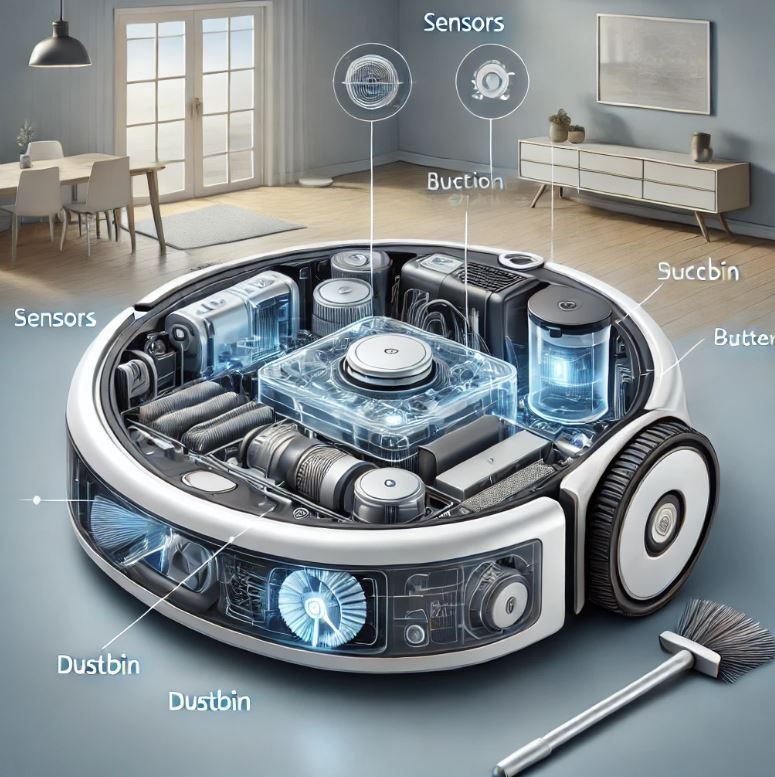I'm a participant in the Amazon Services LLC Associates Program, an affiliate advertising program designed to provide a means for me to earn fees by linking to Amazon.com and affiliated sites.
Robot vacuums have revolutionized the way we clean our homes, offering a convenient, automated solution to one of our most mundane tasks. But how does a robot vacuum work? This article dives into the inner workings of robot vacuums, explaining the technology behind them and how they perform their cleaning duties.
In the market for a new model? Check out our guide on the best cheap robot vacuum. You’ll get a powerful model without a huge price tag.
Key Takeaways
- Sensors and Navigation: Robot vacuums use a combination of sensors and algorithms to navigate and clean efficiently.
- Cleaning Mechanism: They employ brushes and suction to pick up dirt and debris.
- Smart Features: Many models come with advanced features such as Wi-Fi connectivity and mapping technology.
How Robot Vacuums Navigate
Sensors and Mapping
Robot vacuums rely on a variety of sensors to navigate your home. These sensors can include:
- Infrared Sensors: Detect obstacles and changes in floor texture.
- Cliff Sensors: Prevent the vacuum from falling down stairs.
- Bump Sensors: Detect physical obstacles and prompt the vacuum to change direction.
Some advanced models also use laser or camera-based systems to create a map of your home. This allows the vacuum to plan the most efficient cleaning path and avoid obstacles more effectively.
Movement Algorithms
Robot vacuums utilize sophisticated algorithms to determine the best cleaning route. Basic models may use a random navigation pattern, while more advanced models follow systematic paths to ensure thorough coverage. These algorithms help the vacuum adapt to different room layouts and cleaning needs.
The Cleaning Mechanism
Brushes and Suction
The core cleaning components of a robot vacuum include:
- Side Brushes: Sweep dirt and debris into the path of the main brush and suction.
- Main Brush: Often a combination of bristles and rubber, this brush agitates and lifts dirt from the floor.
- Vacuum Suction: Draws dirt and debris into the dustbin.
Dustbin and Filters
Collected dirt and debris are stored in a dustbin, which needs to be emptied regularly. Most robot vacuums also feature filters to trap fine particles and allergens, ensuring clean air is expelled back into the room.
Smart Features and Connectivity
Wi-Fi and App Control
Many modern robot vacuums come equipped with Wi-Fi connectivity, allowing you to control them via a smartphone app. This feature enables remote scheduling, start/stop commands, and monitoring of cleaning progress.
Voice Assistants
Integration with voice assistants like Alexa and Google Home adds another layer of convenience. You can start or stop cleaning sessions with simple voice commands.
Recent Developments in the Field
The robot vacuum market is continuously evolving, with recent innovations aimed at improving efficiency and user experience. Some notable developments include:
- AI and Machine Learning: Enhancing navigation algorithms for better obstacle avoidance and cleaning efficiency.
- Self-Emptying Dustbins: High-end models now feature bases that automatically empty the robot’s dustbin, reducing maintenance.
- Enhanced Mapping: Improvements in camera and laser-based mapping systems provide more accurate home layouts and efficient cleaning paths.
As of July 2024, brands like iRobot and Roborock are leading the charge with these advancements, continuously pushing the boundaries of what robot vacuums can do.
Top Experts and Entities in the Field
Prominent figures in the field, such as Shane Daugherty from CNET and John Velasco of Digital Trends, regularly provide insights and reviews on the latest robot vacuum technologies. Companies like iRobot, Ecovacs, and Roborock are at the forefront of innovation, consistently developing new features and improving existing technologies.
For detailed comparisons and expert reviews, check out websites like Digital Trends and CNET, which offer comprehensive guides and reviews to help you stay updated on the newest advancements and best practices.
Internal Links for Further Reading
For more information on selecting the best vacuum for your specific needs, check out these articles:
- Best Vacuum for Hardwood Floors
- Shark NV360 vs NV501
- Best Vacuum for Stairs
- Tineco Floor One S5 vs iFloor S3
- Tineco Floor One S3 vs S5
Conclusion – How Does a Robot Vacuum Work?
Understanding how a robot vacuum works can help you appreciate the technology behind these handy devices. From advanced sensors and navigation algorithms to efficient cleaning mechanisms and smart features, robot vacuums are a testament to modern engineering. For more insights and reviews on the latest vacuum technologies, visit our website.
Author
Vacuums Pal
Vacuums Pal is a leading expert in the field of vacuum technology, providing comprehensive reviews and insights for many years.
